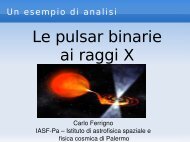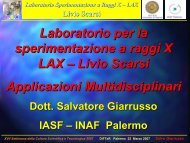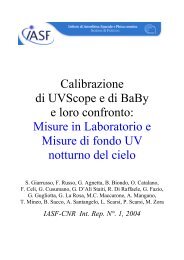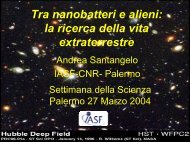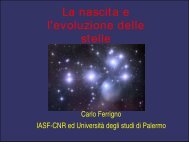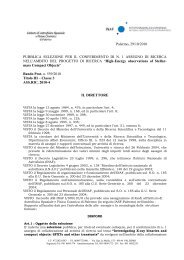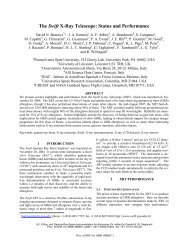GRB 050223 and GRB 050911 - IASF Palermo - Inaf
GRB 050223 and GRB 050911 - IASF Palermo - Inaf
GRB 050223 and GRB 050911 - IASF Palermo - Inaf
Create successful ePaper yourself
Turn your PDF publications into a flip-book with our unique Google optimized e-Paper software.
TABLE 1. γ- <strong>and</strong> X-ray parameters for <strong>GRB</strong>s <strong>050223</strong> <strong>and</strong> <strong>050911</strong>. The times<br />
over which the X-ray fluxes were calculated are given in the last row of the table.<br />
Burst <strong>GRB</strong> <strong>050223</strong> <strong>GRB</strong> <strong>050911</strong> Swift mean<br />
T 90 (s) 23 16 46<br />
15–150 keV T 90 fluence 4.8 × 10 −8 3.0 × 10 −7 2.3 × 10 −6<br />
(erg cm −2 )<br />
0.3–10 keV unabs. flux 8.2 × 10 −13 UL: 1.7 × 10 −14 5.2 × 10 −10<br />
(erg cm −2 s −1 )<br />
time range post-burst (ks) 2.8–4.0 16–716 large range<br />
afterglows of short bursts tend to be fainter <strong>and</strong> fall below the XRT detection threshold<br />
quite rapidly (e.g., Gehrels et al. 2005; Fox et al. 2005b).]<br />
We present here the analysis of two faint bursts: <strong>GRB</strong>s <strong>050223</strong> <strong>and</strong> <strong>050911</strong>. The X-<br />
ray afterglow of <strong>GRB</strong> <strong>050223</strong> was detected by the XRT after ∼ 47 minutes, whereas<br />
<strong>GRB</strong> <strong>050911</strong> remained undetected in an observation starting ∼ 4.6 hours after the burst.<br />
DATA ANALYSIS<br />
<strong>GRB</strong>s <strong>050223</strong> <strong>and</strong> <strong>050911</strong> were faint in both prompt <strong>and</strong> afterglow emission (see Table 1<br />
<strong>and</strong> Figures 1 & 2). In the case of <strong>GRB</strong> <strong>050223</strong>, the X-ray flux at 11 hours (∼ 1 × 10 −13<br />
erg cm −2 s −1 over 0.3–10 keV) was below all those detected by BeppoSAX (Piro 2004).<br />
The flux upper limit of 1.7 × 10 −14 erg cm −2 s −1 for <strong>GRB</strong> <strong>050911</strong> shows that, at<br />
∼ 10 4 s, any X-ray afterglow emission was at least an order of magnitude fainter than all<br />
of the other long bursts detected by Swift, with the possible exception of <strong>GRB</strong> 050421<br />
(Figure 1; Godet et al. 2005; Nousek et al. 2005).<br />
<strong>GRB</strong> <strong>050223</strong> - a large opening/viewing angle or high redshift?<br />
Using the st<strong>and</strong>ard <strong>GRB</strong> afterglow models (Zhang & Mészáros 2004), the data for this<br />
burst are inconsistent with post-jet-break evolution. A large opening angle could explain<br />
both a late jet-break <strong>and</strong> the faintness of the afterglow, as well as the BAT fluence being<br />
relatively low. Alternatively, the low afterglow flux <strong>and</strong> prompt fluence could be caused<br />
by the burst being at high redshift; Swift <strong>GRB</strong>s are at a mean redshift of ∼ 2.1, while<br />
pre-Swift, the mean was ∼ 1.2. More details on the analysis of <strong>GRB</strong> <strong>050223</strong> can be<br />
found in Page et al. (2005a).<br />
<strong>GRB</strong> <strong>050911</strong> - a naked <strong>GRB</strong> or a short burst?<br />
The complete non-detection of an X-ray afterglow is very unusual for Swift bursts,<br />
as mentioned above. Any afterglow corresponding to the burst <strong>GRB</strong> <strong>050911</strong> must have<br />
faded very rapidly or been extremely faint to be undetected at ∼ 4.6 hours. One possible



